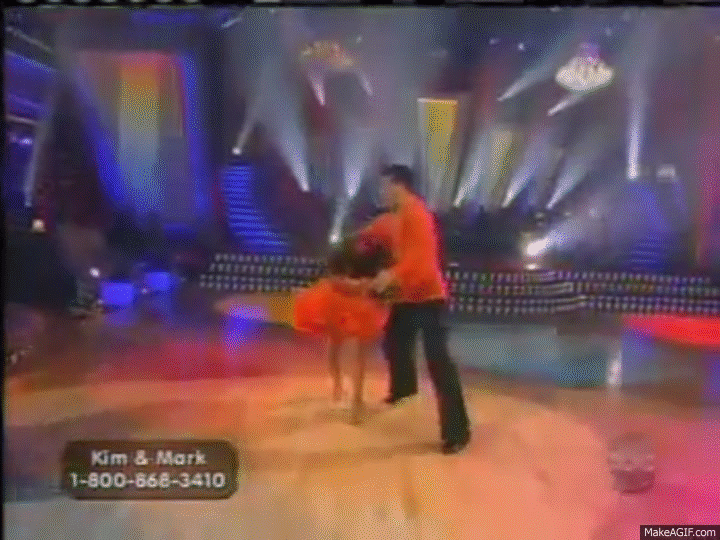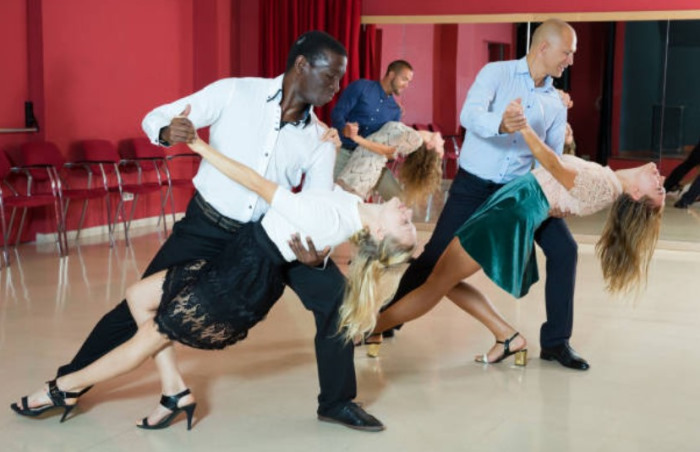Mambo!
If you’ve ever watched West Side Story, whether it’s the 2021 re-make, the cult-classic 1961 version, or the Broadway production … then you know exactly what scene we’re talking about.
And if you’ve seen this scene, we totally understand why you’re looking for how to Mambo dance.
This beautiful, energetic dance could only be described as mesmerizing on the TV screen. There’s a charm of sorts to the energy that all of the participants in the dance display.
If you have fancied yourself being one of them, flittering across the stage, this article is for you!
Here’s how to dance the Mambo for complete beginners.
Table of Contents
How To Mambo Dance For Beginners?
Now before you dive in, there’s one thing we have to tell you first: Mambo is one of the more difficult dances out there that you can learn.
The learning process can be challenging if you have never learned any dance before.
But it’s not impossible! As long as you practice regularly and have a good instructor, you’ll be able to dance the Mambo fluidly in no time.
Another thing: Mambo is mostly a partner dance. So, to best practice, you should find someone to dance with you.
Body Position
There should be a decent amount of space between you and your partner. The positioning will be similar if you have ever watched the Rumba or Cha-cha-cha performance.
The male dancer will have their left hand raised, meeting the right hand of their female partner.
Meanwhile, the male’s right hand will be placed on their partner’s back, directly underneath the left shoulder blade. The woman’s left hand will rest upon her partner’s right shoulder.
Count the Mambo
Counting the steps is one of the most challenging things you will have to learn as a beginner.
While most dances usually start on the first count, Mambo begins on the second count. Even people with dancing experience fumble at this part when they first practice mambo dancing.
So, in Mambo, you skip the first count, then dance on count numbers 2, 3, and 4. These three steps can be counted as two quick and one slow step.
Dance quickly on Count 2 and 3, then slow down on Count 4. The last step is held until the second beat of the next bar in the music.
Basic Steps of the Mambo Dance
Mambo is all about forward and backward motion.
So, for beginners, the most important moves you need to know are the Forward Basic (Forward Break) and the Backward Basic (Rock Back).
Once you have learned the forward-backward motion, you can incorporate hip movements to make your performance more catchy.
We’ll show you how to do both in the segment below. Each method has instructions for two roles: the lead (traditionally male) and the follower (traditionally female).
Forward Basic
- Lead (often Male partner)
If you were to take the lead, start with your feet together.
Put your left foot forward, then shift your weight onto it. Your right foot should stay in place, lengthening as your left foot is brought forward.
Then, rock yourself onto your static right foot, and shift your body weight back until it’s solidly on your right foot.
Once the weight is shifted, slide your left foot back until it is aligned with your right foot. You should be back to your starting position by now.
Shift your weight onto your left foot and prep your right foot for a step to the right. Draw your left foot back when you have done the rightward step, closing up the move.
All of these moves are made with your feet touching the ground. Ideally, the soles of your feet should never lose contact with the dance floor.
To train for this, Mambo dance instructors usually let beginners dance with paper towels under their feet. They must drag the towels along the floor as they learn the footwork.
- Follower (often Female partner)
If you’re the follower, your steps will be very similar to the lead’s.
Start by putting weight onto your left foot, then slide your right foot forward. Rock yourself forward with the slide and transfer your weight over to your right foot.
Shift your weight to the back, and you will naturally take a step with your left foot backward. Draw your right foot back and bring it to rest next to your left foot, closing out the move.
Shift your weight to the right, and prep for the Forward Basic!
Backward Basic
- Lead (often Male partner)
Instead of starting with your left foot like with the Forward Basic, this time, you begin with your right foot.
Take a step back with your rightie, then shift your weight onto it. Your left knee will naturally bend as you do and it shouldn’t move.
Once the weight is rocked onto your right foot, lunge forward onto your left leg.
Take a step forward with your right and close up the move. Change the weight back onto your right leg to prepare yourself for the Forward Basic.
- Follower (often Female partner)
Unlike the lead, extend your left foot and bend your right knee. As you shift your weight onto your left foot, it should look like your body is “rocking” backward.
While you’re doing this, your right foot should stay in place. It shouldn’t move or lift from off the floor.
Rock forward onto your right foot, and close up the move by stepping up with your left.
Continue with your partner to the Forward Basic. The forward and backward motions are done in a cycle until the music’s over.
Try Jazzing It
Notice how we termed the moves above as Forward Basic and Backward Basic?
These are the fundamental moves that you need to know. But if you only do them, you’re not going to be a good Mambo dancer.
Mambo is a wild dance that rewards creativity.
You must combine the basic steps above with other techniques if you want to stand out on the stage. These techniques can be of your own creation or textbook moves.
We have a few here that you can try out.
Drag Around Mambo
The Drag Around Mambo, also called “Drag-Her-Around” or the “Cross-body Lead,” is a classic if you want to energize the dance.
The dance starts with the lead facing the wall and ends with the follower facing the wall.
It has three steps total, and the body weight is shifted onto one foot. It’s not all that different from the basic mambo dance moves. Where it stands out is that there is a 180° pivot turn after the first weight shift.
The follower follows the lead forward, then across, and to the lead’s left side. Then, the follower executes a 180° turn. They then break it up in the last two counts with two 90° turns.
Crossover Break
The Crossover Break is a rather stylistic Mambo dance step.
The two partners dance together while keeping their hands linked together, and their feet turn one-quarter away from one another.
They then moved back to the “fifth position,” also known as the “ballroom position.” The weight of both dancers should be shifted onto their rear feet.
Some Mambo Tips
Always Use Small Steps
Bigger isn’t always better, especially in Mambo.
Mambo dance music can be very fast, so if you use a lot of big steps, sooner or later, you’ll find yourself missing the beat.
Keep your steps small so that you will be able to keep your body and sense of rhythm under control.
Skip Count One
In Mambo, you don’t move on count one. This can be massively confusing for a lot of people. But it can be learned easily with some practice.
Always keep in mind that you can move your hips or flare on count one, but never move your feet until the second count.
Prettify Your Move with Your Hips

Hip movements are super important in Mambo. It’s where the magic lies and how mambo dancers can look so seductive.
When you’re shifting your weight during the Forward or Backward Basic, for example, bend your knees and then straighten them. This will naturally produce a hip movement.
While you may not feel like it, the audience will be enraptured if you do this well!
Check more: How Many Types Of Latin Dance Are There?
Final Words
The pure energy and vibrancy of Mambo make it a timeless dance. Trust us when we say that it’s well worth time practicing!
Hopefully, this guide has given you a better idea of how to mambo dance and how to begin.
Tell us about your experience learning the mambo dance in the comment section below. We’d love to hear your story!


Please, please, please stop saying male and female! Dancing is for everyone. We now use “leader” and “follower”, not “boy” and “girl” or other gendered language.
Thank you!